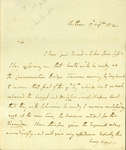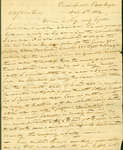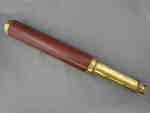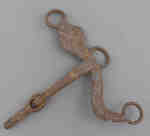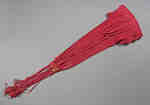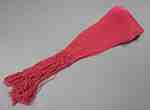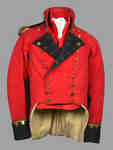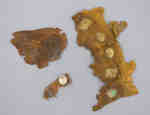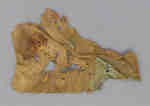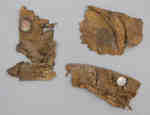Results
- This is a print of a portrait of Jacob Brown. At the bottom it states “From the original painting by Chappel in the possession of the publishers Johnson Fry & Co., Publishers. New York. Entered accorThis is a print of a portrait of Jacob Brown. At the …
- A muster roll, dated July 25 to August 24, 1812, of Jonathon Moore's Company of the 4th Regiment of the Lincoln Militia. This regiment participated in the Battles of Queenston Heights and Lundy's LanA muster roll, dated July 25 to August 24, 1812, of Jonathon …
- Boyd's justification of his conduct and complaints about being dropped from the Army list. Inscribed on page [1]: N. Emery, Esq.Boyd's justification of his conduct and complaints about being dropped from the …
- Published under the auspices of "The Literary and Historical Society of Quebec". Printed by the "Morning Chronicle" Office in Quebec.Published under the auspices of "The Literary and Historical Society of Quebec". …
- A return for ordnance stores for Captain Thos. Biddle's company corps of artillery during the War of 1812. The document is dated June 24, 1814 at the Artillery Encampment, Buffalo, and is signed by JA return for ordnance stores for Captain Thos. Biddle's company corps of …
- A letter from R. Lawson dated at Chatham, September 7, 1812, regarding movement of the 9th infantry. The letter is signed R. Lawson M Genl [Major General].A letter from R. Lawson dated at Chatham, September 7, 1812, regarding …
- A War of 1812 letter written to Josiah Masters, Shaghticoke, New York, from his nephew J.E.A. Masters, dated November 11, 1812. The letter refers to an impending invasion of Canada at Montreal.A War of 1812 letter written to Josiah Masters, Shaghticoke, New York, …
- This is a spotting telescope that is reddish brown in colour with brass fittings. It is 38 cm long and extends to 83 cm. Markings include an inscription that states “G DIXEY LONDON, DAY OR NIGHT”.This is a spotting telescope that is reddish brown in colour with …
- This is a British Officer’s coatee that is double breasted red wool with blue wool on the lapels, stand up collar and cuffs. The buttons are plain and believed to be gilded brass. There are four buttThis is a British Officer’s coatee that is double breasted red wool …
- This is a maroon military sash that includes yellow thread of the ends. It is believed to have been worn by Major Wm. Adams. It is fringed on both ends.This is a maroon military sash that includes yellow thread of the …
- This is a red military sash that is made of silk. It is a mesh weave with fringed ends and measures 147cm x 12 cm.This is a red military sash that is made of silk. It …
- This red wool military coatee is double breasted with blue lapels, a stand up collar and cuffs. There is gold lace trim around the collar as well as along the upper edge of the cuffs. The jacket hasThis red wool military coatee is double breasted with blue lapels, a …
- These are British red coat fragments believed to be from one of Niagara’s Battlefields. This item can currently be found at the Willoughby Museum.These are British red coat fragments believed to be from one of …
- This is a neck stock worn by soldiers to ensure an upright posture and focused attention. This is believed to be from one of Niagara’s Battlefields. This item can currently be found at the WilloughbyThis is a neck stock worn by soldiers to ensure an upright …
- This is a leather shoe sole that is believed to be from one of Niagara’s Battlefields. This item can currently be found at the Willoughby Museum.This is a leather shoe sole that is believed to be from …
- This is uniform fragment is believed to be from one of Niagara’s Battlefields. This item can currently be found at the Willoughby Museum.This is uniform fragment is believed to be from one of Niagara’s …
- These are United States Army grey coat uniform fragments believed to be from one of Niagara’s Battlefields. Theory states that it may be from one of Winfield Scott’s regulars. This item can currentlyThese are United States Army grey coat uniform fragments believed to be …
- This item can currently be found at the Willoughby Museum.This item can currently be found at the Willoughby Museum.
- Written 15 years after the War of 1812's conclusion, this book was authored by David Thompson, late of the Royal Scots and printed by Thomas Sewell of Niagara. Sewell's printery was on the Market SquWritten 15 years after the War of 1812's conclusion, this book was …
When selecting an individual record or object, you will move
to the website of the heritage institution that houses the item.
To return to the search or results pages, select "Back", "Results" or "New Search".
 This project was made possible with the support of the Department of Canadian Heritage
This project was made possible with the support of the Department of Canadian Heritage
through the Canadian Culture Online Strategy.
to the website of the heritage institution that houses the item.
To return to the search or results pages, select "Back", "Results" or "New Search".
 This project was made possible with the support of the Department of Canadian Heritage
This project was made possible with the support of the Department of Canadian Heritage through the Canadian Culture Online Strategy.






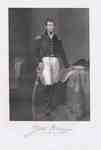



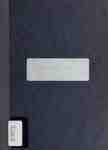
![Fifth series of historical documents : [All relating to the War of 1812]. Fifth series of historical documents : [All relating to the War of 1812].](https://images.ourontario.ca/Partners/BUA/BUA074180t.jpg)

